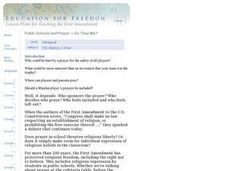Curated OER
Lincoln's Spot Resolutions
Learners take a closer look at historical relations between the United States and Mexico. In this Texas annexation lesson, students examine primary documents authored by Zachary Taylor, James Polk, and Abraham Lincoln to consider why the...
Curated OER
A More Perfect Union: Barack Obama's Race Speech at the National Constitution Center
Eleventh graders explore the process of perfecting the Union through changes made to the Constitution, and through the powers delegated to each branch of government. In this American Government lesson, 11th graders research various...
Curated OER
Wealth and Power: United States v. Microsoft
Students explore wealth and influence in the United States. In this Bill of Rights instructional activity, students listen to their instructor present a lecture regarding the details of the United States v. Microsoft case. Students...
Curated OER
Public Schools and Prayer - Do They Mix?
Students discuss and research different Supreme Court cases and examine religious freedom and prayer in public schools.
Curated OER
Dred Scott and the Constitution
Students investigate the outcome of the Dred Scott case. In this human rights lesson, students read Justice Taney's decision about property rights and citizenship. Students write essays about the outcome of the case and President...
Curated OER
Racism, Discrimination, and the Law
Seventh graders examine the various racism and discrimination faced by various ethnic groups in the United States. In groups, they research the legal system and describe the purpose of the United States Constitution. They review cases...
Curated OER
Twelve Angry Men: Trial by Jury as a Right and as a Political Institution
Students explore the constitutional guarantee of the right to trial by jury. In this U. S. Constitution instructional activity, students read or view Twelve Angry Men and respond to discussion questions regarding the jury. Students...
Curated OER
Civil Rights Leader: Rosa Parks
All humans should have civil rights, but that wasn't the case in Alabama. This biographical presentation shares information about the life and inspiration that Rosa Parks brought to the Civil Rights movement. It explains her thoughts,...
NYC Department of Records
Citizenship and Elections: The Importance of a Ballot
Approximately 58 prcent of those eligible voted in the 2016 US Presidential election. In an attempt to impress upon learners the importance of voting and voting rights, class members examine primary source documents related to the...
Curated OER
Tribal Sovereignty Mock Trial
Students discuss the issue of tribal/native nation sovereignty. They review the Constitution of the U.S. and discuss how it legally provides for sovereign nations. Then they participate in a mock trial of the 1823 Supreme Court Case...
Curated OER
The Turbulent 1960s (5)
In this online interactive American history worksheet, students respond to 14 matching questions regarding 1960's America. Students may check their answers immediately.
Curated OER
Near v. Minnesota
Students discuss what free press means and what it would be like without this right. They read the summary from the Near v. Minnesota case. In groups, they analyze a problem and report to the class.
Curated OER
Should Homosexuals Have the Right to Laws Protecting Them From Discrimination?
Students explore discrimination issues in America. In this homosexual rights lesson, students listen to their instructor lecture on antidiscrimination laws and gay rights. Students respond to questions about the Romer v. Evans case.
Curated OER
Hazelwood v. Kuhlmeier (1988)
Students explore the concept of student press rights. In this case study lesson, students read excerpts of Hazelwood v. Kuhlmeier. Students then complete the provided worksheet activities and determine whether they agree with the outcome...
Curated OER
Tinker v. Des Moines (1969)
Students explore the concept of symbolic speech. In this case study lesson, students read excerpts of Tinker v. Des Moines. Students then complete the provided worksheet activities and determine whether they agree with the outcome of the...
Judicial Learning Center
About Federal Judges
Not just anybody can do the job of a federal judge, but according to the United States Constitution just about anybody can be appointed. The lesson outlines the process and requirements for becoming a federal judge, focusing on the...
Curated OER
Due Process of Law and the Jim Crow Era
Students analyze eight case studies of Supreme Court decisions regarding due process of law and their impact on American society in the early 20th century. They digest that although the 14th amendment was intended to give federal rights...
Curated OER
The Right to Remain Resilient
Students examine the Civil Rights Movements in the U.S., both current and historic. In small groups students investigate a specific civil rights group, create an illustrated timeline, noting key events, people, and state and federal laws.
Curated OER
Researching American Democracy
Students compare Watergate and the Clinton/Lewinsky scandal. In this U.S. Constitution lesson, students define vocabulary terms and read articles regarding the impeachment process. Students respond to questions that require them to...
Curated OER
We the People: 270 out of 538
Students engage in a instructional activity that helps them better explain the quadrennial ritual surrounding the election of a president in the United States of America.
Curated OER
Ex Parte Milligan
Middle schoolers reserach the case of Ex Parte Milligan. They explore the influence of the Supreme Court and the court decisions on the rights and responsibilities of citizens. They read Milligan's letter to Stanton and generate...
Curated OER
Society in the 1950s (5)
In this online interactive American history worksheet, students respond to 8 matching questions regarding 1950's America. Students may check their answers immediately.
Curated OER
Lee Yick: Fighting Racism
Students study the 14th Amendment, then review and analyze a Supreme Court brief. There was much racism exhibited toward the Chinese immigrants by the European Americans; this came in the form of institutional racism and mob violence....
Curated OER
THE JUDICIAL BRANCH
Students create a series of drawings to show the process of how the Supreme Court does its work. The drawings may be in strip cartoon form or a series of separate illustrations.

























